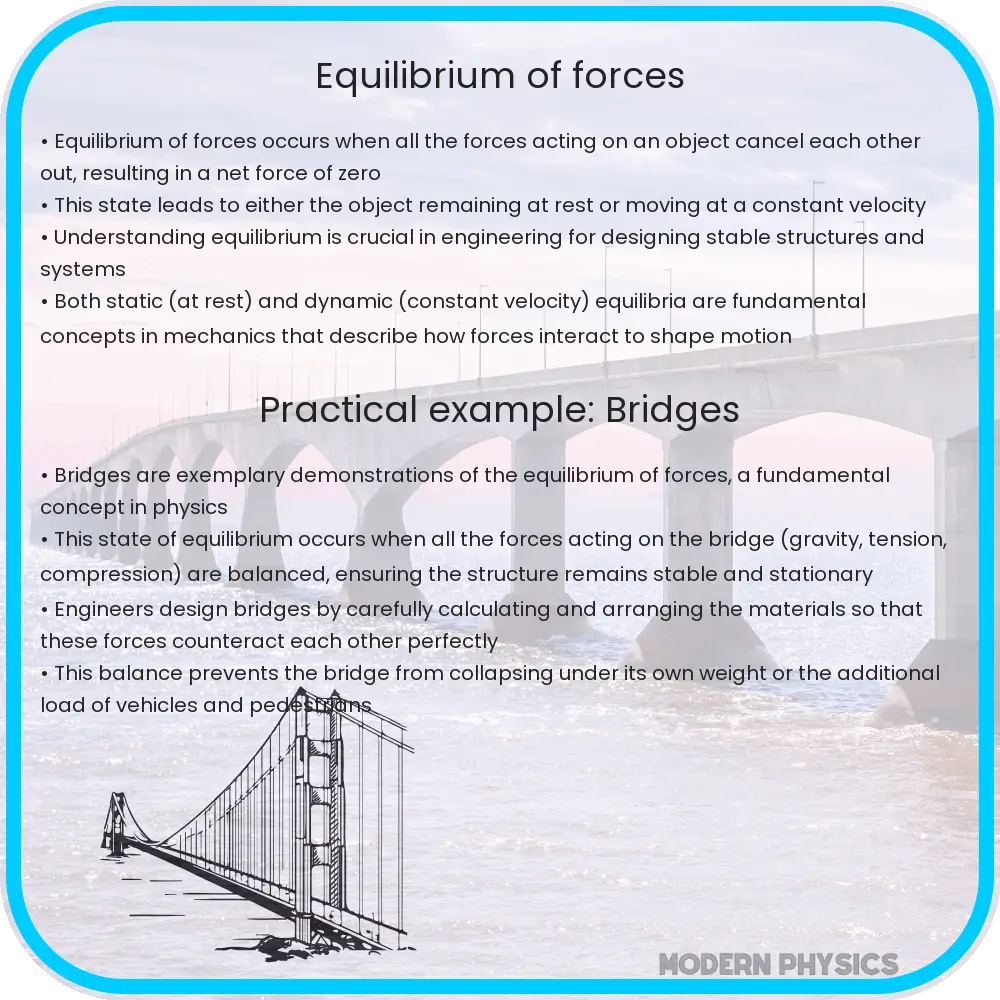Explore the essentials of force equilibrium in statics, its applications in structural analysis, and advanced techniques for real-world engineering.

Understanding Equilibrium of Forces in Statics
The concept of equilibrium of forces is a fundamental principle in statics, the branch of mechanics dealing with bodies at rest or moving at constant velocity. It’s pivotal in understanding how structures maintain stability and how forces are distributed within them. This principle is applied in various fields, including engineering, construction, and physics.
Basics of Force Equilibrium
Force equilibrium occurs when all the forces acting on a body are balanced, resulting in no net force. This condition is articulated by Newton’s First Law of Motion, which states that a body at rest will remain at rest, and a body in motion will continue in motion with a constant velocity unless acted upon by a net external force. In mathematical terms, this is expressed as:
- Sum of Forces (ΣF) = 0: The vector sum of all forces acting on a body is zero.
- Sum of Moments (ΣM) = 0: The sum of moments (or torques) about any point is zero.
Components of Force Equilibrium
In analyzing force equilibrium, forces are often broken down into components. This simplification allows for the application of the equilibrium conditions in different directions (usually along x, y, and z axes in a Cartesian coordinate system).
Application in Statics
In statics, equilibrium analysis is used to determine the forces in structures like beams, trusses, and frames. It helps in calculating the reactions at supports, internal forces within members, and the conditions for stability. For instance, in beam analysis, equilibrium principles are used to find bending moments and shear forces that are crucial for structural design.
Real-World Analysis
Equilibrium of forces isn’t just a theoretical concept; it has practical applications in everyday life. From the design of bridges and buildings to the stability of furniture and machinery, understanding force equilibrium is essential. It ensures structures can withstand applied loads without collapsing and helps in designing objects that are both functional and safe.
Advanced Analysis in Equilibrium of Forces
Advanced analysis in statics often involves complex structures where multiple forces and moments interact. Engineers use various methods like the method of joints, method of sections, and graphical techniques to analyze these systems. In these analyses, the equilibrium conditions are applied to each component or section of the structure, leading to a comprehensive understanding of the force distribution throughout the system.
Impact of Material Properties
Material properties significantly influence the analysis of force equilibrium. The strength, elasticity, and plasticity of materials determine how they will react under different loads. For example, in a steel beam under tension, the material’s yield strength and modulus of elasticity are critical factors in determining how much load it can bear before it deforms or fails.
Equilibrium in Dynamic Conditions
While statics deals with bodies at rest or moving at a constant velocity, the principles of equilibrium also apply in dynamics to a certain extent. In dynamics, the forces are balanced, but acceleration is considered, leading to more complex equations of motion. However, the basic principle that the sum of forces and moments equals zero under equilibrium remains valid.
Computational Tools in Equilibrium Analysis
Modern engineering extensively utilizes computational tools for equilibrium analysis. Software like finite element analysis (FEA) programs allow engineers to model complex structures and simulate the effects of various forces and moments. These tools have revolutionized the field, enabling the analysis of extremely complex systems that would be impractical to analyze manually.
Conclusion
Understanding the equilibrium of forces is crucial in the field of statics and beyond. It forms the backbone of structural analysis and design, ensuring that structures are safe, stable, and efficient. From simple mechanical systems to complex architectural marvels, the principles of force equilibrium guide engineers and designers in creating sustainable and robust structures. As technology advances, the tools for analyzing force equilibrium continue to evolve, paving the way for more innovative and groundbreaking designs in the future.
